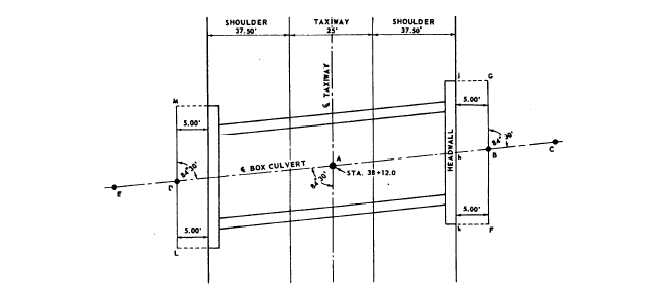For projects such as this, the EA surveyor is often
required to perform as-built surveys to determine the
work in place for each of the construction activities.
These surveys are usually performed on a periodic
basis, such as biweekly or monthly. The results of
these surveys are then used to determine the
completion percentage of the project.
When doing as-built surveys for the purpose of
monitoring and reporting progress, the techniques, or
methods, that you use are nothing unique. Simply use
the method that is best suited for the job at hand. Also,
for this type of as-built surveying, extreme accuracy
is usually not required; for example, if you are
determining how much of a total road surface has been
paved, measurements to the nearest foot are usually
sufficient.
Now let’s look at some stakeout surveys.
Culverts and Bridges
As in other types of layout for construction, the
stakeout of culverts and bridges generally includes
providing line and grade. The procedures and
precision required will vary with the magnitude and
complexity of the job.
DITCHES AND CULVERTS.— For minor open
drains or outfall ditches a few feet deep, a single line
of stakes will serve for both alignment and grade. By
running profile levels, you can determine the
elevations of the tops of the stakes. As a guide to the
construction workers, mark the cut on each stake to
show the depth of drain below each station.
For drains that are very deep, you must cross-
section the line and set slope stakes. The grade for a
ditch is measured along the flow line; that is, along the
bottom of the ditch.
When pipe culverts without wing walls and aprons
are staked, only the alignment and invert grade are
required; however, when head walls, wing walls, and
aprons are used to intercept drainage water, to retain
earthwork, and to prevent erosion, grade stakes, as
well as horizontal alignment stakes, will be required.
Large bridge culverts and box culverts require stakes
and hubs for batter board alignment similar to those
required for a building layout.
Figure 10-11 illustrates the stakeout of a box
culvert that crosses below an airfield taxiway. The
angle at which the culvert crosses below the taxiway
may be written on the plans, or it may be taken from
the plans.
Assume that this angle is 84°30´, as shown. To run
the center line of the culvert, setup the transit at A and
turn the 84°30´ angle from the center line of the
taxiway.
Place reference stakes at B, C, D, and E along the
culvert center line far enough beyond the limits of the
culvert to make sure they are not disturbed by the
construction work. In this case, points B and D are set
arbitrarily at 5 feet (measured at right angles) from the
location of the outside face of the culvert headwalls.
Figure 10-11.—Stakeout of a box culvert.
10-15

